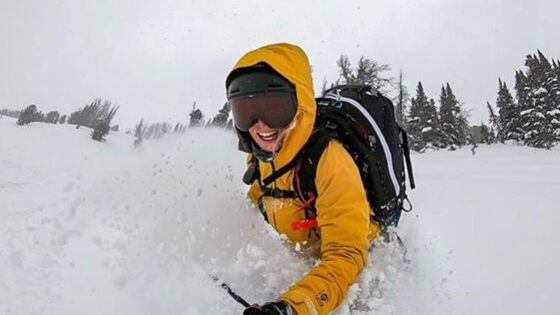Not all pow stashes are created equal. If you know where to go, you will score more, even inbounds.
Team rider Izzy Lazarus @izzylazarus discovers ways to stay in tune with the snowpack during her season on resort at Jackson Hole.
By the time the ball dropped to mark the start of 2018, I had already toured about 25 days and was looking to keep up that average through the rest of the winter. I was tuned into the snowpack to a degree that I hadn’t experienced before in my career as a backcountry snowboarder. Nearly every day I was out romping around, listening to, testing and riding on the snow and had a pretty good sense of what was going on and how to ride safely in the backcountry.
Fast forward one year and things are a little different. I took a position as a snowboard instructor at Jackson Hole Mountain Resort to challenge myself with something new and to balance out my skillset. I love teaching people of all ages and getting to be by their side for their first soul turn. I’m enjoying exploring the mountain with all its hidden features and plethora of cliffs to sneak around.
There is just one thing… I miss the wild mountains so much. I’ve toured a handful of times since Thanksgiving. I feel disconnected from the part of me that has been so defining over the last few winters.

So instead of moping around, wishing that I was making my way through the mountains, Im going to have to put in a little more effort on the home-front to stay connected. I’ve realized that reading the present-day avalanche forecast is not enough to understand where I can ride both safe and fresh snow. I need to be my own tracker and forecaster to be able to anticipate these things, so that’s what I am working towards.
Whether I am going to teach at the resort or I am going deep into the backcountry my morning routine is this….

First, I go to the 24hour weather summary. I am currently recording the information from two weather stations (Rendezvous and Summit) and then read through details from the rest. For your local zone, understand where these stations are located and how relevant the information is to you. http://jhavalanche.org/viewBigsheet

I record the present, max and min temperatures first. Is the snow getting dried out or wet? How is the surface snow reacting to temperature changes? Colder temps (v warm temps) will dry out the snowpack and can begin the faceting process. Another thing to consider is the angle of the slope you want to ski. Steeper slopes will see more sun affect than lower angle slopes.
Then, I work my way down to wind speeds and I look at the current speed and direction and the 24-hour total and direction. Is there snow available for transport? Where will I find wind slabs, scouring, loading?
Next, is snowfall rate and water equivalency and the snow depth. New snow is exciting for all riders, it's the chance to wipe the canvas clean and lay new tracks down. I am looking at the overall accumulation and its percentage of water. Did we get 20” of 15% or 10” of 4%. I’ll take the later, please. The total snow depth tells me how much snow we received in periods of precipitation and then in dry cycles I can see whether or not the snow is settling and at what rate.


Ok, moving on from crunching numbers , the next page I look at it the avalanche event details section. Where have avalanches been occurring? Are they being triggered naturally or by the weight of single skier? What layer are they failing on and where does that problem exists? How big are these slides, D1 or are we seeing historic slides? You can draw a compass rose on a piece of paper and mark where slides are occurring (elevation and aspect) throughout the season.
 Avalanche Crown. Photo sourced from Grant Gunderson Photography.
Avalanche Crown. Photo sourced from Grant Gunderson Photography.
Now we have an idea of what the weather has been doing and if the snow is being reactive or are we seeing things settle out.
I’ve got some historical data, so now I am moving on to the weather forecast. I use several weather forecast sites to develop an earnest picture of what might happen today. My go-to’s are moutnainweather.com and the RPK forecast. What will the temps be, high or low winds, am I going to have 100 mile views or totally socked in for the day. How will todays temps affect the snowpack, is it getting weaker or stronger?



